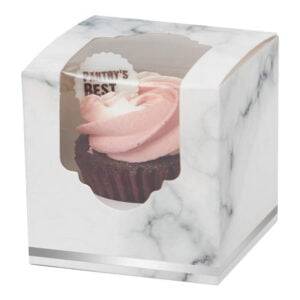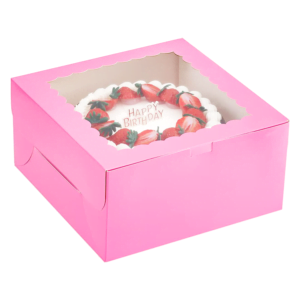Cake box packaging is not just about aesthetics; it’s also about ensuring your delicious creations arrive at their destination intact and in perfect condition. Choosing the right size for your cake boxes is a crucial decision that impacts both the presentation and protection of your cakes. In this comprehensive guide, we will delve into the intricacies of selecting the perfect size for your cake box packaging, ensuring that your cakes not only look delectable but also reach their destination in pristine condition.
1. Introduction
 Cake box packaging is an art that combines aesthetics with functionality. While it’s essential for your cake boxes to look appealing and showcase your creations, they must also be the right size to protect your cakes during transport and delivery. In this article, we will guide you through the process of choosing the perfect size for your cake box packaging.
Cake box packaging is an art that combines aesthetics with functionality. While it’s essential for your cake boxes to look appealing and showcase your creations, they must also be the right size to protect your cakes during transport and delivery. In this article, we will guide you through the process of choosing the perfect size for your cake box packaging.
2. Understanding Cake Sizes
2.1. Standard Cake Sizes
Cakes come in various standard sizes, from small individual portions to large multi-tiered creations. It’s essential to understand these standard sizes and the variations they entail. Common cake sizes include 6-inch, 8-inch, 10-inch, and 12-inch rounds or squares.
2.2. Special Occasion Cakes
Special occasions often call for custom cake sizes. Wedding cakes, for example, can range from modest two-tier designs to extravagant multi-tier masterpieces. These custom sizes require specific attention when choosing the right cake box dimensions.
3. Factors to Consider When Choosing Cake Box Size
3.1. Cake Dimensions
The physical dimensions of your cake, both in terms of diameter (for round cakes) or length and width (for rectangular or square cakes), play a crucial role in selecting the right box size. The box must comfortably accommodate the cake without squishing it or leaving excessive empty space.
3.2. Cake Height
The height of your cake, including any decorations or toppers, is another critical factor. Ensure that the cake box provides enough vertical clearance to avoid damaging the cake’s top decorations.
3.3. Decorations and Toppers
Intricate cake decorations and elaborate toppers require extra consideration. The cake box should be tall enough to accommodate these elements without touching or damaging them.
3.4. Transport and Handling
Think about how the cake will be transported and handled. If the cake will be moved frequently or over long distances, choose a cake box that provides ample protection to prevent shifts or damage during transit.
4. Determining the Right Box Dimensions
4.1. Length and Width
The length and width of the cake box should be slightly larger than the cake’s base dimensions. This ensures a snug fit without compressing the cake. Measure the cake’s base accurately to determine the required length and width of the box.
4.2. Height and Depth
The box’s height and depth should be determined by the cake’s height, including any decorations or toppers. Add a few inches for clearance to ensure the cake is fully protected.
5. Practical Tips for Measuring Cakes
- Use a ruler or measuring tape to measure the cake’s dimensions accurately.
- Measure the cake’s height from the base to the highest point, including any protruding decorations or toppers.
- Account for any potential variations in cake height due to factors like frosting or filling.
6. Best Practices for Cake Box Sizing
6.1. Snug Fit vs. Extra Space
While it’s essential for the cake box to provide a snug fit, avoid choosing a box that is too tight, as it can damage the cake. On the other hand, excessive empty space can lead to shifting and potential damage during transport. Strive for a balance that offers a secure fit without compromising the cake’s integrity.
6.2. Avoiding Compromises
Resist the temptation to select a cake box that doesn’t perfectly match your cake’s dimensions. Compromising on size can lead to damage or a less-than-optimal presentation. It’s worth investing in custom-sized cake boxes if necessary.
7. FAQs
7.1. Can I use a slightly larger box for my cake if I don’t have the exact size?
It’s generally not recommended to use a significantly larger box, as it can lead to shifting and damage during transport. It’s better to invest in custom-sized cake boxes or choose the closest standard size.
7.2. What if my cake has tall decorations or toppers?
If your cake has tall decorations or toppers, choose a cake box with extra height to accommodate them comfortably without touching the top.
7.3. Are there standard cake box sizes available for special occasion cakes?
While there are standard sizes for round and square cakes, special occasion cakes often require custom-sized boxes to ensure a perfect fit. These custom boxes can be ordered from packaging suppliers.
7.4. Can I cut the cake to fit into a smaller box?
Cutting a cake to fit into a smaller box is not recommended, as it can compromise the cake’s appearance and integrity. It’s better to choose a larger box or invest in custom-sized packaging.
8. Conclusion
Choosing the right size for your cake box packaging is a critical aspect of ensuring that your cakes are not only visually stunning but also reach their destination in pristine condition. Take into account the cake’s dimensions, height, decorations, and how it will be transported when selecting the appropriate box size. Remember that a well-fitted cake box not only protects your creation but also enhances the overall presentation, leaving a sweet impression on your customers or recipients.

